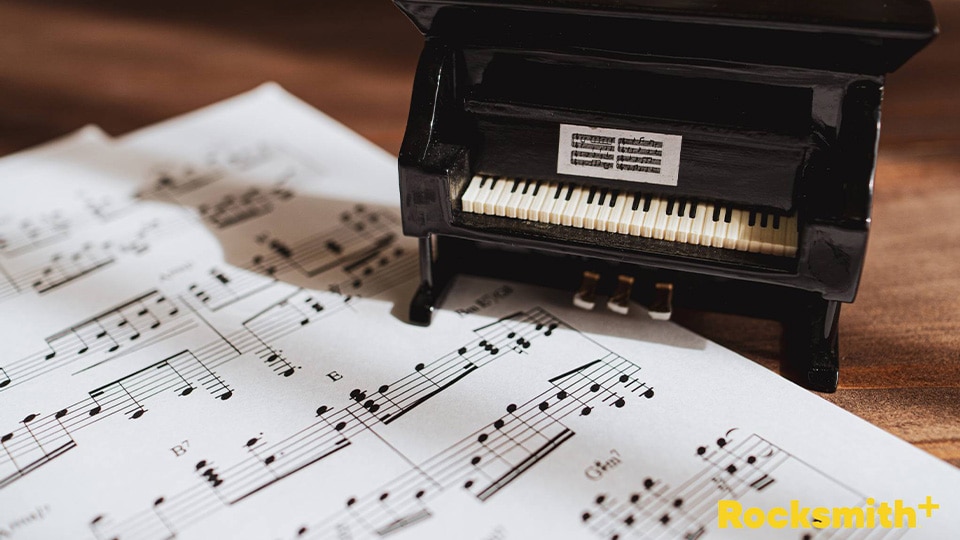Unlocking the world of music starts with understanding the foundational elements, and for pianists, this begins with the piano keyboard. Each key tells a story, each note evokes an emotion, and combined, they create the magic that we know as music.
As a beginner piano player, or someone curious about the instrument, the piano might seem a bit daunting with its myriad of keys and terms. However, with the right resources, such as a piano notes chart, even the newest player can quickly grasp the basics, making the learning journey enjoyable and rewarding.
What Are the Basics of the Piano?
When learning to play piano, it's important to build a strong foundation --- by knowing the basics.
Piano Keys
At first glance, a piano keyboard showcases a pattern of white and black keys. These keys represent the musical notes you'll play. White keys are the natural notes (A, B, C, D, E, F, G), while the black keys represent sharps and flats, serving as bridges between certain white keys. Understanding this distinction is foundational to learning piano.
Piano Keyboard Layout
The layout of the piano is systematic and repetitive. The same pattern of white and black keys repeats across the entire length of the piano, representing different octaves of the same note names. Taking a look at a piano notes chart can help you visualize this repetitive pattern, making it easier to identify note names across the keyboard.
Middle C
One of the most referenced keys for beginners is the Middle C. Situated almost at the center of the keyboard, Middle C serves as an anchor point. When you start your piano lessons, this key will often be your starting point, helping you orient yourself on the keyboard and in reading sheet music.
Bass Clef vs. Treble Clef
When you delve into piano music, you'll come across two primary symbols: bass clef and treble clef. Bass clef, usually played with the left hand, represents the lower range of notes. In contrast, the treble clef, played with the right hand, denotes the higher range. Recognizing these clefs and understanding their significance is vital as they guide which hand plays which notes and where they're located on the musical staff.
As we journey further into the world of piano music, these basics will serve as the building blocks, enabling a deeper understanding and appreciation of the instrument. Whether you're aiming to play classical masterpieces, contemporary pop, or jazz improvisations, this foundational knowledge is your first step to mastery.
What Is a Piano Notes Chart?
![[RS+] Piano Notes Chart: Visualize Your Music SEO ARTICLE - Piano notes chart](http://staticctf.ubisoft.com/J3yJr34U2pZ2Ieem48Dwy9uqj5PNUQTn/4dAv4VcHobSskUNkYVjH8V/83bf7215811392f81c2098199078ceb4/chart2.jpg)
A piano notes chart is a visual tool that displays the layout of the piano keys along with their corresponding keyboard note names. Picture a diagram showcasing both the white and black keys of a piano or keyboard, with each key labeled with its musical note.
This chart serves multiple purposes:
- Visual Learning: For visual learners, a piano notes chart provides a quick snapshot of the entire keyboard, allowing them to understand the relationships between different notes easily.
- Reference Tool: Whether you're a beginner familiarizing yourself with the keyboard, the chart offers an instant reference point.
- Teaching Aid: Instructors often utilize piano notes charts to help students understand the layout of the keyboard and the placement of each note.
- Memory Boost: For those attempting to memorize the position of each note, having a visual representation can significantly enhance recall.
The beauty of the piano notes chart lies in its simplicity. While the piano is a complex instrument, this chart breaks down its vast array of keys into an easily digestible format, making the journey of learning more approachable.
What Are White Notes and Black Notes?
While the white and black keys on a piano keyboard offer a visual distinction, understanding their musical differences is essential. White notes represent the natural tones, which are the seven basic notes: A, B, C, D, E, F, and G. Black notes, on the other hand, represent sharps and flats, which are essentially the notes that fall in between the natural tones. For instance, the black note between A and B can be called A# (A sharp) or B♭ (B flat), depending on the context.
Musical Alphabet
The musical alphabet is the foundation of music theory. Running from A to G, these seven letters cycle repeatedly across the keyboard and the broader world of music. By learning these notes on the piano, you'll find it easier to pick up other musical instruments or delve deeper into the intricacies of musical compositions.
Major Scale
Among the various scales in music, the Major scale is perhaps the most fundamental, especially for beginners. Taking C major as an example, it's played using only the white keys, starting from Middle C. Its sequence of notes (C-D-E-F-G-A-B-C) gives us a delightful and familiar tune that's central to many compositions.
Octaves
![[RS+] Piano Notes Chart: Visualize Your Music SEO ARTICLE - Octaves](http://staticctf.ubisoft.com/J3yJr34U2pZ2Ieem48Dwy9uqj5PNUQTn/6TFtbbebTT917bf4hKQMBq/defff2681fb15dd3bc196794e898dd3e/chart3.png)
An octave represents a set of eight notes. On the piano, the distance between one C and the next C (or any note and its next occurrence) is called an octave. Recognizing octaves and understanding their placement can aid in quickly navigating the keyboard and recognizing patterns in piano music.
Piano Notes: Basic Concepts
![[RS+] Piano Notes Chart: Visualize Your Music SEO ARTICLE - basic concepts](http://staticctf.ubisoft.com/J3yJr34U2pZ2Ieem48Dwy9uqj5PNUQTn/3F7FeyIqe2MqVJ7V4Eahrs/e1ec7a7e6ba3b541da45bc8e284dc87a/chart4.jpeg)
Now that we've covered some foundational knowledge around piano notes charts, let's talk about a few basic concepts you can use to your advantage when working on the piano.
Chord Building
Knowing the names of each note is crucial when constructing chords. For instance, to play a C major chord, you need to strike the C, E, and G notes simultaneously. With a chart, you can easily identify these notes.
For more complex chords like 7th or 9th chords, a chart helps players identify and remember the individual notes that constitute these chords. Chords can be played in various positions, known as inversions. Having a visual reference makes it easier to understand and practice these inversions.
Creating Fills and Runs
Many are based on specific chord shapes or patterns. By having an understanding of chords and the layout of the piano, you can create new runs and accents to songs.
Recognizing the distance and relationships between keys is vital when creating fills or runs between chords. A chart can aid players in visualizing these relationships.
For players who like to improvise, knowing the scale associated with a chord can help in creating melodies or fills on the fly. A chart offers a quick reference for these scales.
Enhancing Music Theory Knowledge
Music, in many cases, is based on certain music theories and styles. Over time, as music theories are better understood you'll be able to better anticipate changes and upcoming styles in songs. The easier music becomes to play, the more you will enjoy jamming out to new songs.
Understanding scales is foundational in music theory. A piano notes chart helps players visualize and play various scales, from major and minor to more complex modes.
Intervals refer to the distance between two notes, and these, too, are key knowledge. A chart can assist in understanding these intervals, crucial for both melody and harmony creation.
Boosting Memory and Confidence
The longer you play an instrument, and the more comfortable you feel with note and chord changes, the better you'll feel about trying new genres, styles, and the more fun playing new songs will become.
Constantly referencing a chart while practicing reinforces note names and their positions, gradually enabling players to play without the need for visual aids.
For beginners, having a tool that demystifies the keyboard can be a confidence booster. It ensures they're hitting the right notes, helping them progress faster.
Songwriting and Composition
Learning a new instrument is a way to express yourself and release your emotions and experiences through song. Now you're not trying to write the next number one hit, you're just trying to create an outlet for all that stuff built up inside.
When crafting a melody, a chart can guide songwriters in choosing the right notes that fit within their chosen key or scale.
For those looking to add harmonies or counter-melodies, a chart can be invaluable in ensuring the notes chosen harmonize correctly with the main melody.
In essence, a piano notes chart serves as a roadmap, guiding players through the vast landscape of the keyboard. It simplifies complex concepts, aids in the application of music theory, and ultimately empowers players to express themselves more freely on the instrument.
The Power of the Piano Notes Chart
In the world of music, tools come in various forms, from physical instruments to intricate software. Yet, sometimes, it's the simplest tools that have the most profound impact. The piano notes chart is a testament to this. It's more than just a collection of keys and their respective names; it's a bridge between a novice's curiosity and a maestro's expertise.
As a reference, the chart is like a compass, guiding players through the vast sea of white and black keys, ensuring they always find their way. Whether you're deciphering complex chords or trying to grasp the foundation of a new scale, this chart ensures you're never lost.
In today's digital age, with the myriad of resources available at our fingertips, the piano notes chart can literally be in your back pocket --- a quick pull away on your smartphone or tablet whenever you need a quick reminder or clarification.
So, whether you're at the dawn of your musical journey or somewhere along its path, keep this chart close. Let it be your silent partner, always ready to assist, ensuring every note played resonates with confidence, clarity, and creativity. In the grand symphony of learning the piano, the piano notes chart is, without a doubt, an unsung hero.
For more tools and tricks to advancing your musical journey, check out Rocksmith+ and the ever-growing library of knowledge.
Sources:
Piano Keys: Theory, History, and Secrets Unlocked | Grand Piano Passion
Where Is Middle C? (Various Instruments, Explained Simply) | Producer Hive
Classification of Visual and Non-visual Learners | National Library of Medicine
Musical Alphabet | Virginia Commonwealth University









